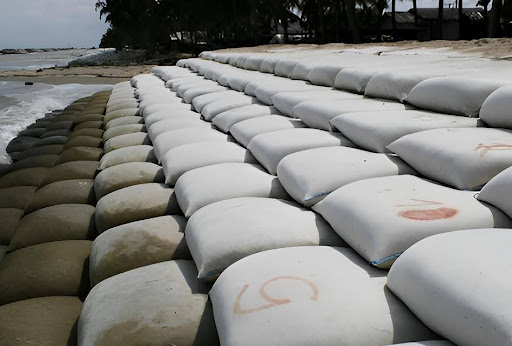STABILITY is essential to the success of any construction project. From roads to retaining walls, long-term performance depends on proper ground reinforcement.
Geosynthetic materials have become key in modern engineering, providing effective solutions for soil stabilization, load distribution, and erosion control. With different types serving specific roles, selecting the right geosynthetic is crucial for lasting stability and cost efficiency.
Introduction to geosynthetic reinforcements
Geosynthetic reinforcements are essential in geotechnical engineering, providing effective support for weak subgrades, erosion control, and long-term infrastructure stability. As construction grows more complex, understanding these materials helps ensure the right choice for each project.
What Are geosynthetic reinforcements?
Geosynthetic reinforcements are polymer-based materials used with soil to enhance strength and stability. Made from durable polymers like polypropylene or polyester, they serve key functions such as reinforcement, filtration, drainage, and separation. Widely applied in civil engineering, they help stabilize roads, support retaining walls, manage water, and reinforce slopes.
Why geosynthetics are crucial for soil and structural stability
Natural soil often lacks the strength to support heavy loads or resist movement, especially in challenging conditions. Geosynthetics reinforce the soil by adding tensile strength, limiting deformation, and improving stability. This enhances structural integrity and reduces risks like settlement, erosion, and slope failure.
Key benefits of using geosynthetic materials in construction
Geosynthetic materials offer practical and cost-effective benefits by improving load distribution and allowing construction over weak soils with minimal excavation. Their flexibility accelerates projects, reduces waste, and supports long-term durability with low-maintenance solutions for erosion control and drainage.
Main types of geosynthetic reinforcements
Geosynthetic reinforcements come in various types, each tailored for specific engineering functions like reinforcement, separation, drainage, or erosion control. Knowing how each type works is key to selecting the right material for effective construction and design.
Geotextiles – nonwoven and woven variants
Geotextiles are fabric-like materials widely used in civil engineering for separation, reinforcement, and filtration. Woven types offer high tensile strength for soil support, while nonwoven versions are more porous and better suited for filtration and drainage. Both are essential in stabilizing roads, slopes, and retaining walls.
Geogrids – for soil reinforcement and slope stability
Geogrids are grid-like materials that reinforce soil by interlocking with it, enhancing shear strength and preventing lateral movement. They are commonly used in slopes, embankments, and retaining walls to improve soil stability and reduce failure risks, offering both strength and flexibility in demanding conditions.
Geocells – cellular confinement systems
Geocells are 3D honeycomb-like structures that confine soil or aggregate, distributing loads and preventing lateral movement. They’re especially effective on soft soils and erosion-prone areas, providing surface stability for applications like roadbeds, embankments, channel linings, and vegetated slopes.
Geonets – drainage and separation functions
Geonets are net-like geosynthetics designed to allow water or gases to flow through soil layers while keeping them separated. Commonly used in drainage systems for landfills, retaining walls, and roads, they help control moisture and reduce hydrostatic pressure, indirectly supporting soil stability.
Geocomposites – multi-layered reinforcement solutions
Geocomposites are hybrid materials that combine different geosynthetics to deliver multiple functions, such as reinforcement, filtration, drainage, and separation, all in one system. Commonly used in complex infrastructure like tunnels, road subbases, and landfills, they offer efficient solutions for multi-layered design requirements.
Factors to consider when choosing geosynthetic reinforcements
Choosing the right geosynthetic reinforcement requires more than just knowing the types available. Factors like load demands, soil conditions, environment, and cost must be considered to ensure the material performs well over the project’s lifespan.
Load-bearing capacity and project requirements
Each construction project has specific load demands that require geosynthetics with suitable strength and stiffness. Matching the material’s load-bearing capacity to the project ensures stable support and reduces the risk of settlement or failure.
Soil type and site conditions
Soil behavior under load depends on factors like composition, moisture, and compaction. Different soil types, such as sand, silt, or clay, pose unique challenges. Site conditions like slope, groundwater, and weather must also be considered to choose the most effective geosynthetic reinforcement.
Durability and resistance to environmental factors
Geosynthetics in construction must withstand harsh conditions like UV exposure, chemicals, and extreme temperatures. Choosing durable materials ensures long-term performance, especially in infrastructure projects where maintenance or replacement is costly and complex.
Cost-effectiveness and long-term performance
Though geosynthetics may have higher initial costs, their durability, easy installation, and low maintenance often make them more economical over time. Considering total ownership costs helps ensure smarter, long-term investment decisions.
Applications of geosynthetic reinforcements for stability
Geosynthetic reinforcements are widely used in construction and environmental projects for their ability to improve ground performance and prevent instability. They offer reliable solutions for applications ranging from infrastructure support to erosion control.
Road construction and pavement support
In road construction, geosynthetics reinforce base layers, enhance load capacity, and reduce surface deformation. They lower material needs, cut costs, and extend pavement life by minimizing rutting and improving durability under traffic.
Retaining walls and slope protection
Retaining walls and slopes face significant lateral pressures that can lead to failure without proper support. Geosynthetics like geogrids and geotextiles reinforce the backfill, enhance stability, and enable steeper, more efficient designs with fewer structural materials.
Embankments and bridge abutments
Geosynthetics are widely used in embankments and bridge abutments, especially on weak or variable soils. They reinforce the subsoil, reduce settlement, and enhance structural stability, while also cutting down on foundation preparation time and costs.
Erosion control and coastal protection
In erosion-prone areas like coastlines, riverbanks, and drainage channels, geosynthetics protect soil from being washed away by water or wind. Materials like geotextiles and geocells stabilize the ground, support vegetation growth, and reduce the need for hard structures such as concrete or riprap.
Conclusion: Ensuring stability with the right geosynthetic reinforcements
Choosing the right geosynthetic reinforcement is essential for building stable, long-lasting structures. Each type, whether it be geotextiles, geogrids, geocells, or geocomposites, all have unique benefits suited to specific project needs.
By considering load demands, soil conditions, environmental factors, and cost, engineers can enhance both safety and performance. As reliability and sustainability become top priorities, geosynthetics remain key to long-term structural stability, and companies such as VeroGroup Construction are here to help supply high-quality geosynthetics for your project, ensuring efficient, sustainable, and high-quality groundwork for construction. —July 30, 2025
Main image: Vero Group




